FYA002-0 Portfolio: Analyzing Terrorism & Mental Health in Society
VerifiedAdded on 2023/06/18
|26
|5719
|252
Portfolio
AI Summary
This assignment is a portfolio focusing on understanding individuals and society, specifically addressing terrorism and mental health from sociological perspectives. It includes analysis of a newspaper article on terrorism using a conflict perspective, explaining how this perspective views terrorism as a result of inequality and dominance. Furthermore, it explores the sociological approach to mental health, emphasizing environmental and social contexts, key thinkers in the field, and key points explaining mental health, including social determinants and the importance of mental wellbeing. The portfolio is designed to demonstrate the student's understanding of sociological theories and their application to real-world issues.
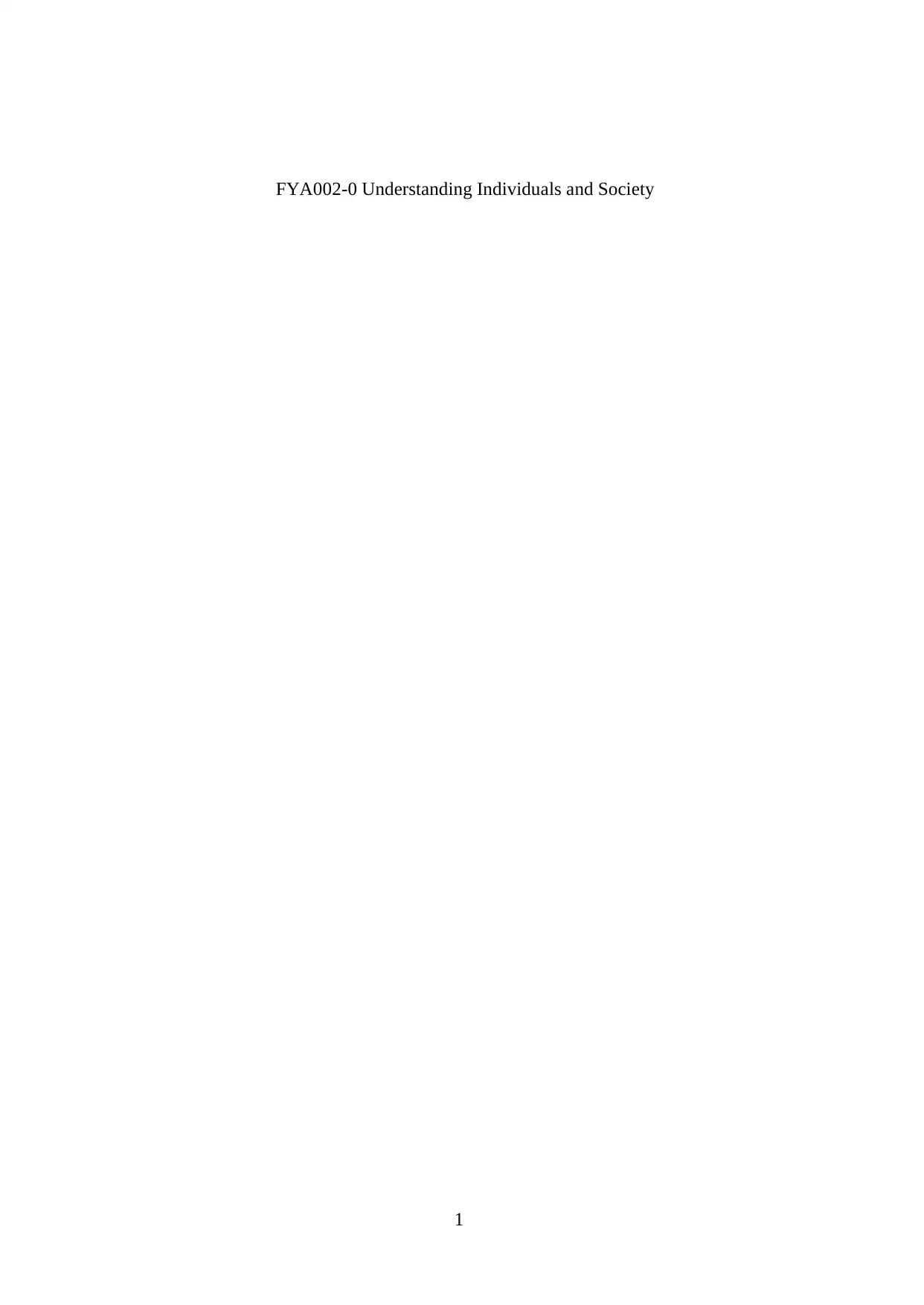
FYA002-0 Understanding Individuals and Society
1
1
Paraphrase This Document
Need a fresh take? Get an instant paraphrase of this document with our AI Paraphraser
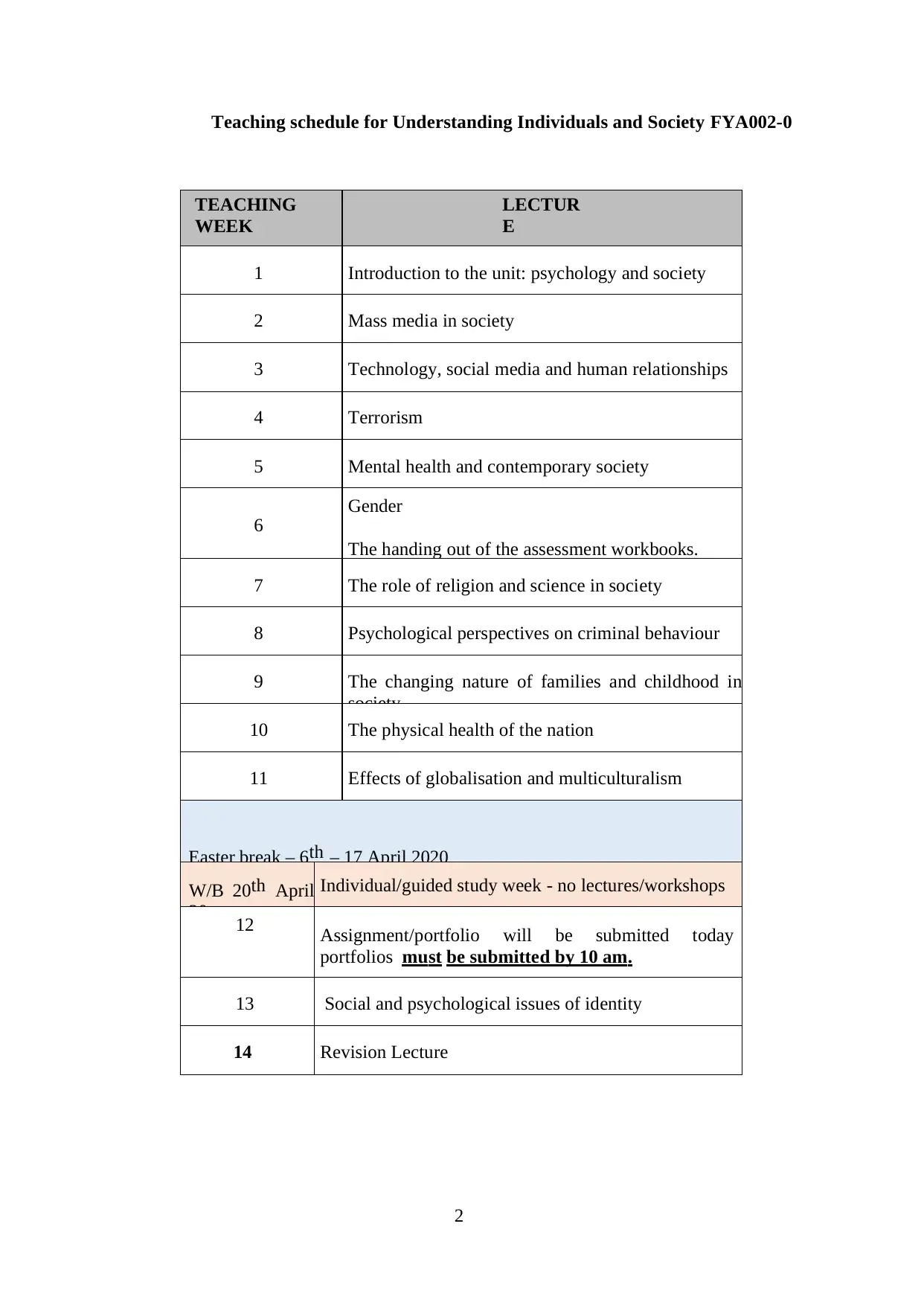
Teaching schedule for Understanding Individuals and Society FYA002-0
TEACHING
WEEK
LECTUR
E
1 Introduction to the unit: psychology and society
2 Mass media in society
3 Technology, social media and human relationships
4 Terrorism
5 Mental health and contemporary society
6
Gender
The handing out of the assessment workbooks.
7 The role of religion and science in society
8 Psychological perspectives on criminal behaviour
9 The changing nature of families and childhood in
society
10 The physical health of the nation
11 Effects of globalisation and multiculturalism
Easter break – 6th – 17 April 2020
W/B 20th April
20
Individual/guided study week - no lectures/workshops
12 Assignment/portfolio will be submitted today
portfolios must be submitted by 10 am.
13 Social and psychological issues of identity
14 Revision Lecture
2
TEACHING
WEEK
LECTUR
E
1 Introduction to the unit: psychology and society
2 Mass media in society
3 Technology, social media and human relationships
4 Terrorism
5 Mental health and contemporary society
6
Gender
The handing out of the assessment workbooks.
7 The role of religion and science in society
8 Psychological perspectives on criminal behaviour
9 The changing nature of families and childhood in
society
10 The physical health of the nation
11 Effects of globalisation and multiculturalism
Easter break – 6th – 17 April 2020
W/B 20th April
20
Individual/guided study week - no lectures/workshops
12 Assignment/portfolio will be submitted today
portfolios must be submitted by 10 am.
13 Social and psychological issues of identity
14 Revision Lecture
2
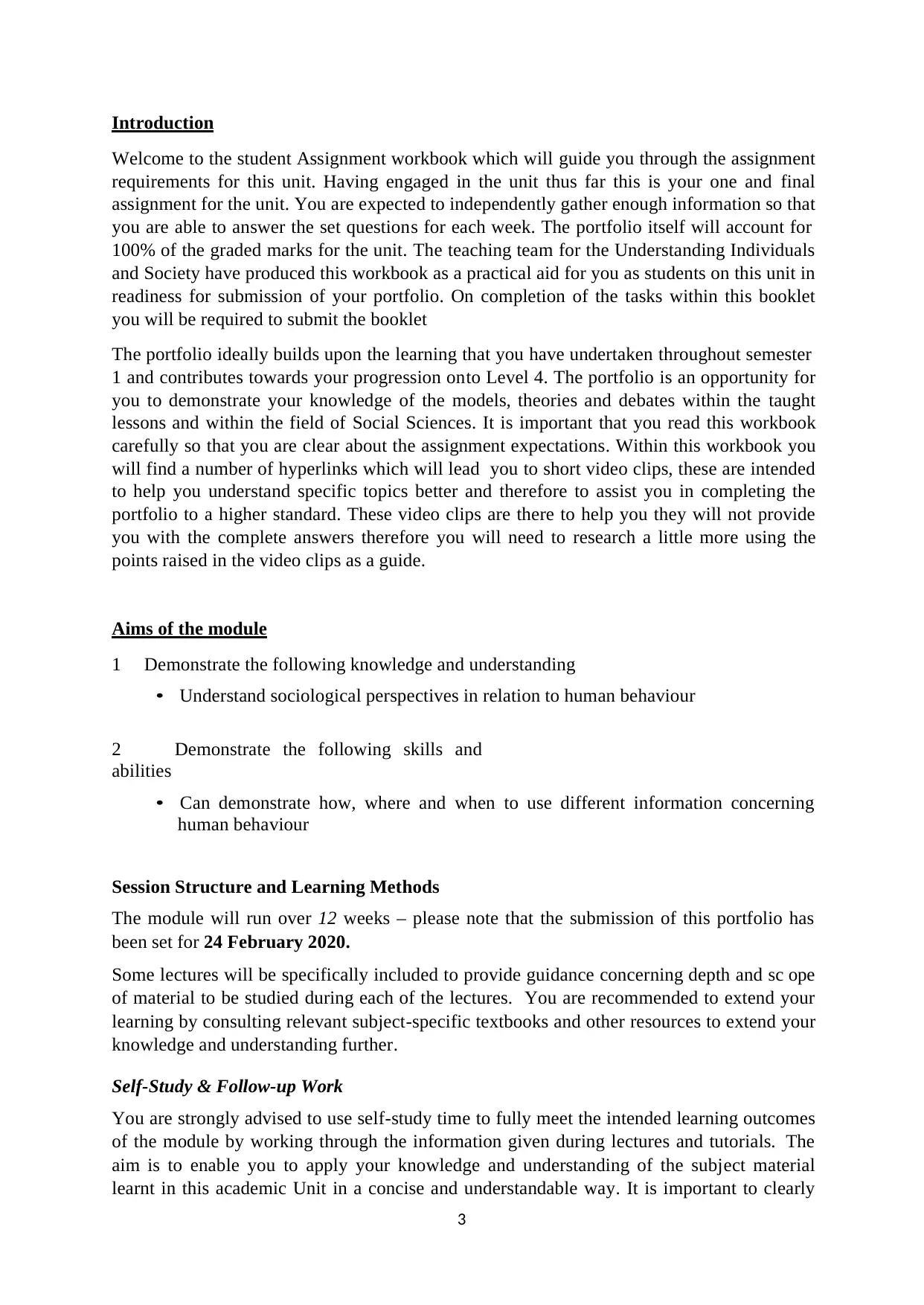
3
Introduction
Welcome to the student Assignment workbook which will guide you through the assignment
requirements for this unit. Having engaged in the unit thus far this is your one and final
assignment for the unit. You are expected to independently gather enough information so that
you are able to answer the set questions for each week. The portfolio itself will account for
100% of the graded marks for the unit. The teaching team for the Understanding Individuals
and Society have produced this workbook as a practical aid for you as students on this unit in
readiness for submission of your portfolio. On completion of the tasks within this booklet
you will be required to submit the booklet
The portfolio ideally builds upon the learning that you have undertaken throughout semester
1 and contributes towards your progression onto Level 4. The portfolio is an opportunity for
you to demonstrate your knowledge of the models, theories and debates within the taught
lessons and within the field of Social Sciences. It is important that you read this workbook
carefully so that you are clear about the assignment expectations. Within this workbook you
will find a number of hyperlinks which will lead you to short video clips, these are intended
to help you understand specific topics better and therefore to assist you in completing the
portfolio to a higher standard. These video clips are there to help you they will not provide
you with the complete answers therefore you will need to research a little more using the
points raised in the video clips as a guide.
Aims of the module
1 Demonstrate the following knowledge and understanding
• Understand sociological perspectives in relation to human behaviour
2 Demonstrate the following skills and
abilities
• Can demonstrate how, where and when to use different information concerning
human behaviour
Session Structure and Learning Methods
The module will run over 12 weeks – please note that the submission of this portfolio has
been set for 24 February 2020.
Some lectures will be specifically included to provide guidance concerning depth and sc ope
of material to be studied during each of the lectures. You are recommended to extend your
learning by consulting relevant subject-specific textbooks and other resources to extend your
knowledge and understanding further.
Self-Study & Follow-up Work
You are strongly advised to use self-study time to fully meet the intended learning outcomes
of the module by working through the information given during lectures and tutorials. The
aim is to enable you to apply your knowledge and understanding of the subject material
learnt in this academic Unit in a concise and understandable way. It is important to clearly
Introduction
Welcome to the student Assignment workbook which will guide you through the assignment
requirements for this unit. Having engaged in the unit thus far this is your one and final
assignment for the unit. You are expected to independently gather enough information so that
you are able to answer the set questions for each week. The portfolio itself will account for
100% of the graded marks for the unit. The teaching team for the Understanding Individuals
and Society have produced this workbook as a practical aid for you as students on this unit in
readiness for submission of your portfolio. On completion of the tasks within this booklet
you will be required to submit the booklet
The portfolio ideally builds upon the learning that you have undertaken throughout semester
1 and contributes towards your progression onto Level 4. The portfolio is an opportunity for
you to demonstrate your knowledge of the models, theories and debates within the taught
lessons and within the field of Social Sciences. It is important that you read this workbook
carefully so that you are clear about the assignment expectations. Within this workbook you
will find a number of hyperlinks which will lead you to short video clips, these are intended
to help you understand specific topics better and therefore to assist you in completing the
portfolio to a higher standard. These video clips are there to help you they will not provide
you with the complete answers therefore you will need to research a little more using the
points raised in the video clips as a guide.
Aims of the module
1 Demonstrate the following knowledge and understanding
• Understand sociological perspectives in relation to human behaviour
2 Demonstrate the following skills and
abilities
• Can demonstrate how, where and when to use different information concerning
human behaviour
Session Structure and Learning Methods
The module will run over 12 weeks – please note that the submission of this portfolio has
been set for 24 February 2020.
Some lectures will be specifically included to provide guidance concerning depth and sc ope
of material to be studied during each of the lectures. You are recommended to extend your
learning by consulting relevant subject-specific textbooks and other resources to extend your
knowledge and understanding further.
Self-Study & Follow-up Work
You are strongly advised to use self-study time to fully meet the intended learning outcomes
of the module by working through the information given during lectures and tutorials. The
aim is to enable you to apply your knowledge and understanding of the subject material
learnt in this academic Unit in a concise and understandable way. It is important to clearly
⊘ This is a preview!⊘
Do you want full access?
Subscribe today to unlock all pages.

Trusted by 1+ million students worldwide
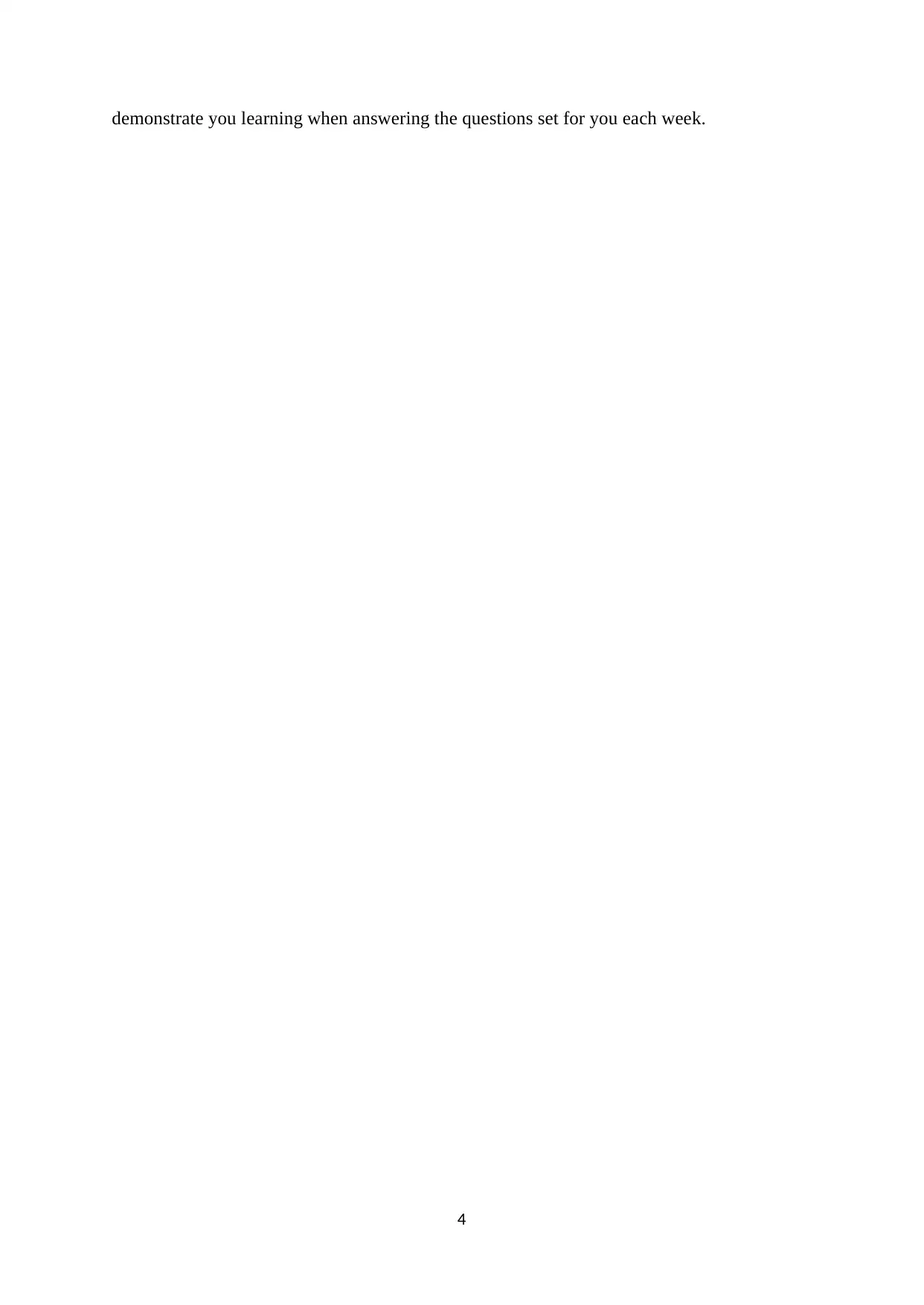
4
demonstrate you learning when answering the questions set for you each week.
demonstrate you learning when answering the questions set for you each week.
Paraphrase This Document
Need a fresh take? Get an instant paraphrase of this document with our AI Paraphraser
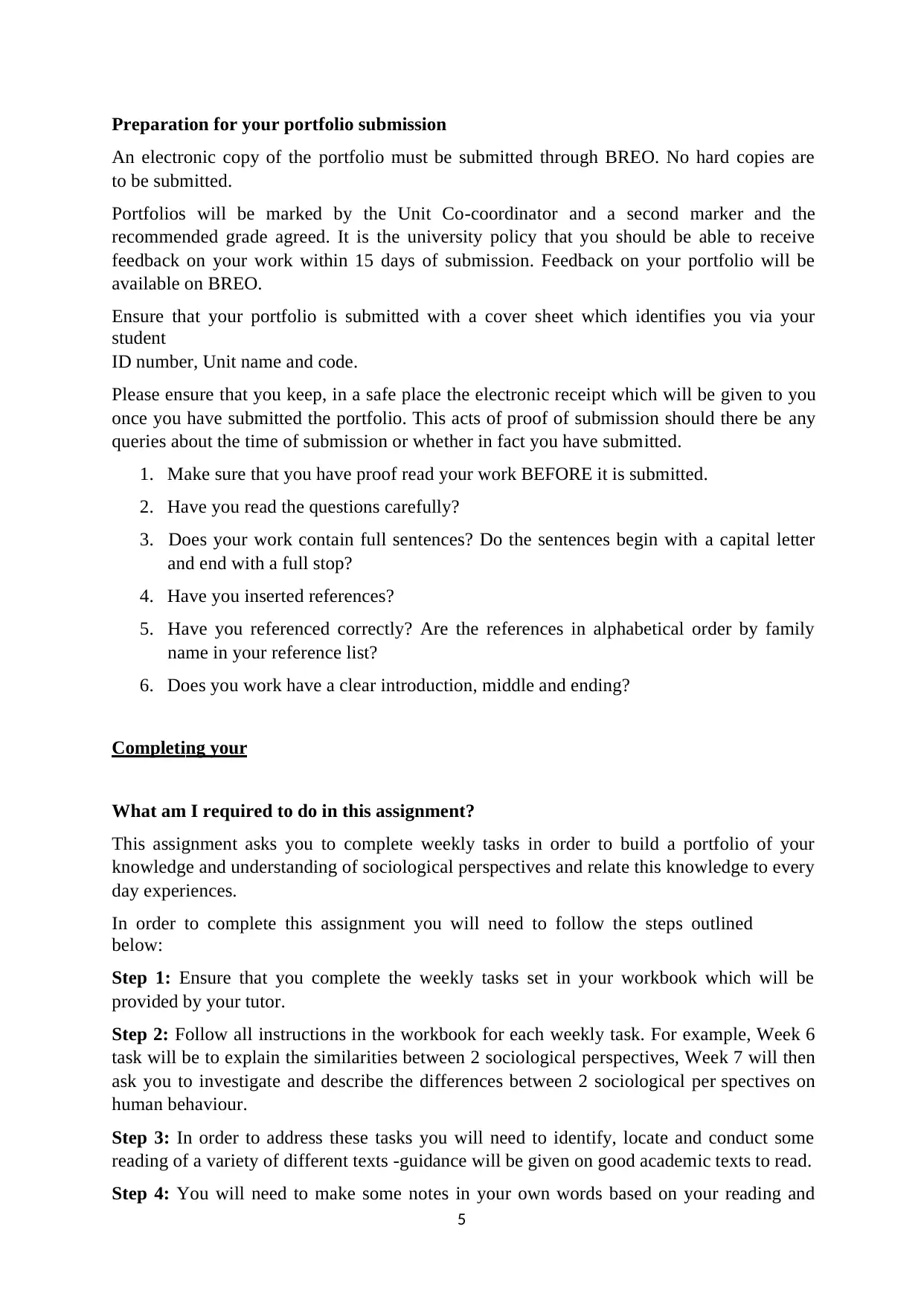
5
Preparation for your portfolio submission
An electronic copy of the portfolio must be submitted through BREO. No hard copies are
to be submitted.
Portfolios will be marked by the Unit Co-coordinator and a second marker and the
recommended grade agreed. It is the university policy that you should be able to receive
feedback on your work within 15 days of submission. Feedback on your portfolio will be
available on BREO.
Ensure that your portfolio is submitted with a cover sheet which identifies you via your
student
ID number, Unit name and code.
Please ensure that you keep, in a safe place the electronic receipt which will be given to you
once you have submitted the portfolio. This acts of proof of submission should there be any
queries about the time of submission or whether in fact you have submitted.
1. Make sure that you have proof read your work BEFORE it is submitted.
2. Have you read the questions carefully?
3. Does your work contain full sentences? Do the sentences begin with a capital letter
and end with a full stop?
4. Have you inserted references?
5. Have you referenced correctly? Are the references in alphabetical order by family
name in your reference list?
6. Does you work have a clear introduction, middle and ending?
Completing your
What am I required to do in this assignment?
This assignment asks you to complete weekly tasks in order to build a portfolio of your
knowledge and understanding of sociological perspectives and relate this knowledge to every
day experiences.
In order to complete this assignment you will need to follow the steps outlined
below:
Step 1: Ensure that you complete the weekly tasks set in your workbook which will be
provided by your tutor.
Step 2: Follow all instructions in the workbook for each weekly task. For example, Week 6
task will be to explain the similarities between 2 sociological perspectives, Week 7 will then
ask you to investigate and describe the differences between 2 sociological per spectives on
human behaviour.
Step 3: In order to address these tasks you will need to identify, locate and conduct some
reading of a variety of different texts -guidance will be given on good academic texts to read.
Step 4: You will need to make some notes in your own words based on your reading and
Preparation for your portfolio submission
An electronic copy of the portfolio must be submitted through BREO. No hard copies are
to be submitted.
Portfolios will be marked by the Unit Co-coordinator and a second marker and the
recommended grade agreed. It is the university policy that you should be able to receive
feedback on your work within 15 days of submission. Feedback on your portfolio will be
available on BREO.
Ensure that your portfolio is submitted with a cover sheet which identifies you via your
student
ID number, Unit name and code.
Please ensure that you keep, in a safe place the electronic receipt which will be given to you
once you have submitted the portfolio. This acts of proof of submission should there be any
queries about the time of submission or whether in fact you have submitted.
1. Make sure that you have proof read your work BEFORE it is submitted.
2. Have you read the questions carefully?
3. Does your work contain full sentences? Do the sentences begin with a capital letter
and end with a full stop?
4. Have you inserted references?
5. Have you referenced correctly? Are the references in alphabetical order by family
name in your reference list?
6. Does you work have a clear introduction, middle and ending?
Completing your
What am I required to do in this assignment?
This assignment asks you to complete weekly tasks in order to build a portfolio of your
knowledge and understanding of sociological perspectives and relate this knowledge to every
day experiences.
In order to complete this assignment you will need to follow the steps outlined
below:
Step 1: Ensure that you complete the weekly tasks set in your workbook which will be
provided by your tutor.
Step 2: Follow all instructions in the workbook for each weekly task. For example, Week 6
task will be to explain the similarities between 2 sociological perspectives, Week 7 will then
ask you to investigate and describe the differences between 2 sociological per spectives on
human behaviour.
Step 3: In order to address these tasks you will need to identify, locate and conduct some
reading of a variety of different texts -guidance will be given on good academic texts to read.
Step 4: You will need to make some notes in your own words based on your reading and
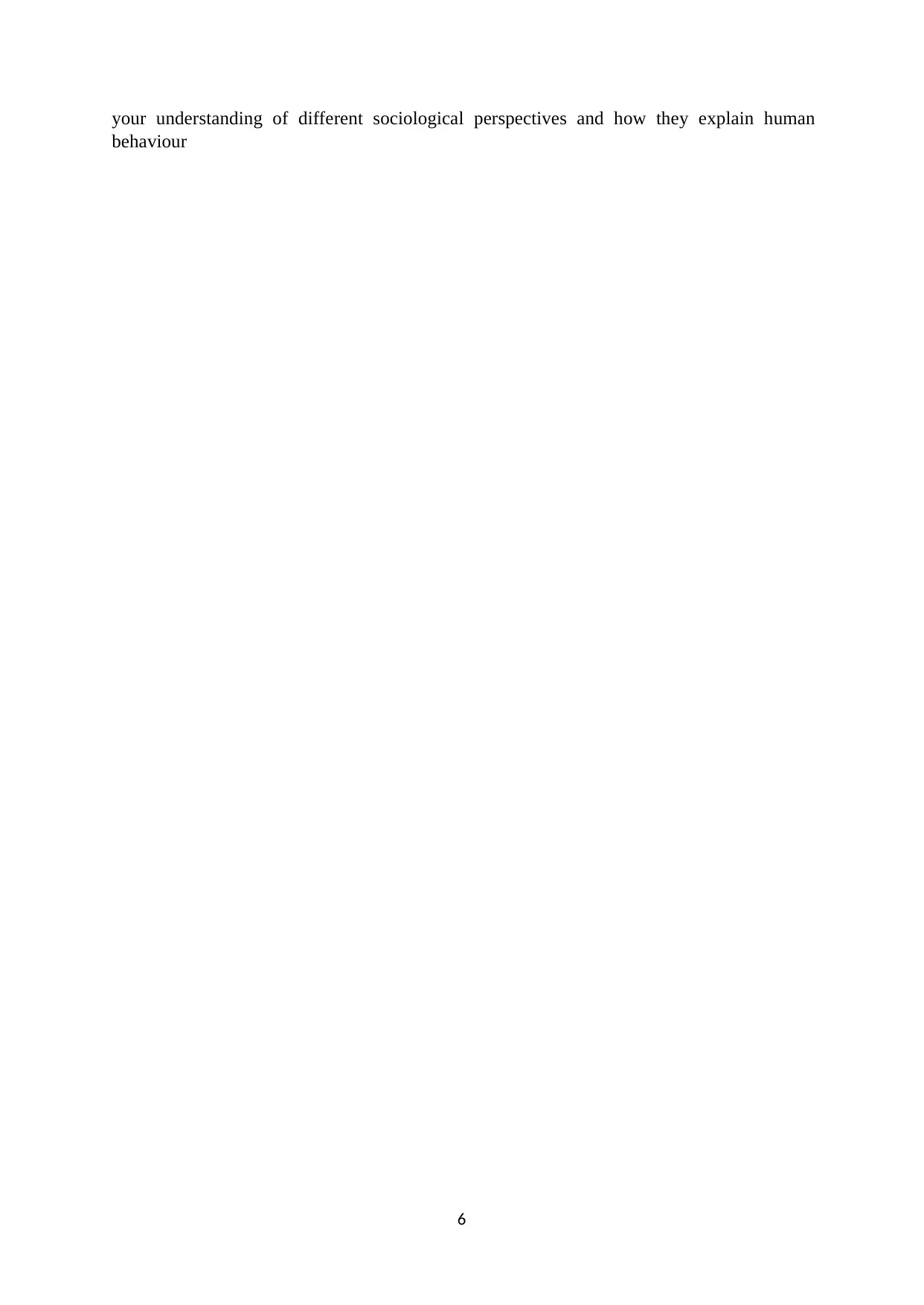
6
your understanding of different sociological perspectives and how they explain human
behaviour
your understanding of different sociological perspectives and how they explain human
behaviour
⊘ This is a preview!⊘
Do you want full access?
Subscribe today to unlock all pages.

Trusted by 1+ million students worldwide
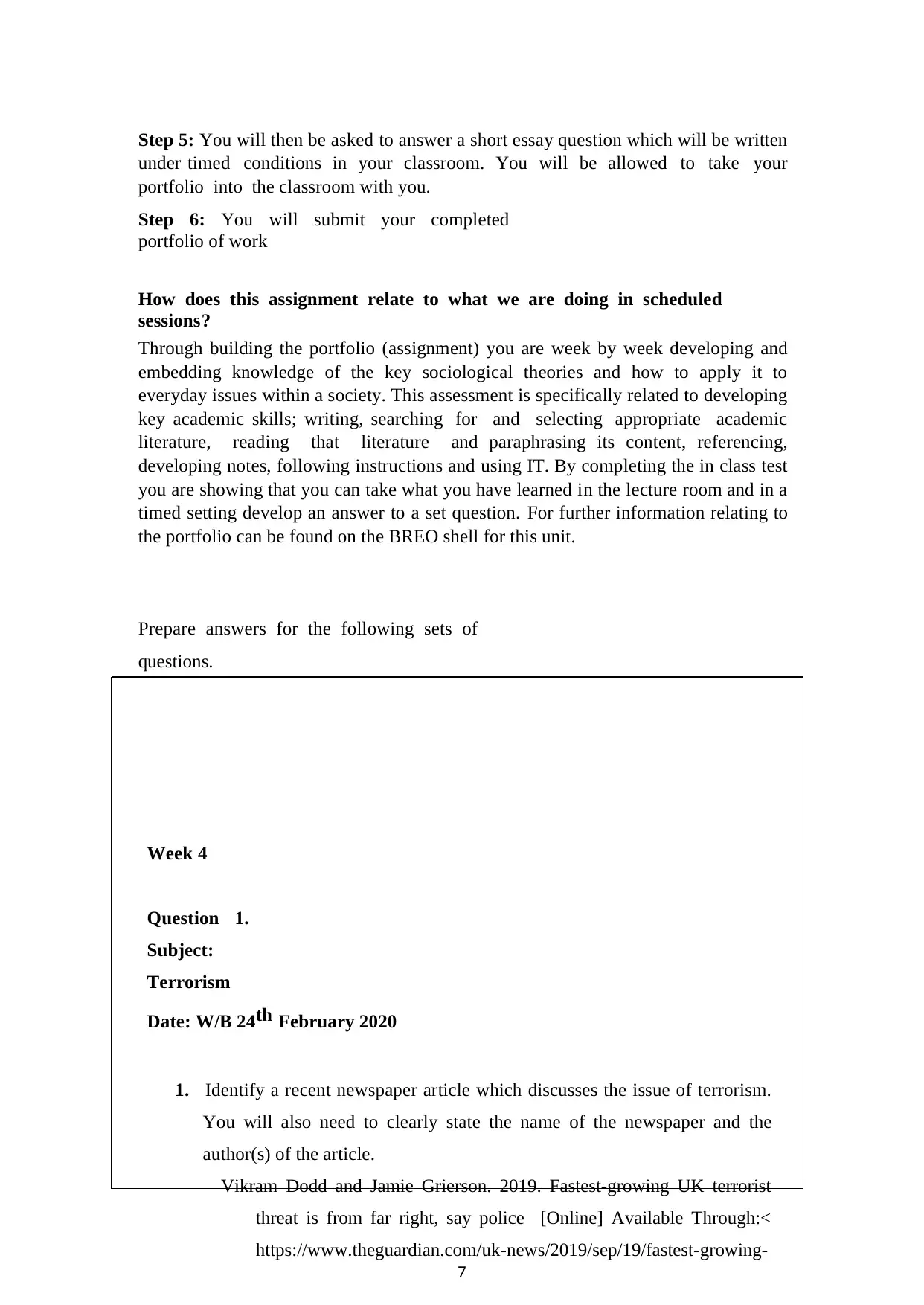
Step 5: You will then be asked to answer a short essay question which will be written
under timed conditions in your classroom. You will be allowed to take your
portfolio into the classroom with you.
Step 6: You will submit your completed
portfolio of work
How does this assignment relate to what we are doing in scheduled
sessions?
Through building the portfolio (assignment) you are week by week developing and
embedding knowledge of the key sociological theories and how to apply it to
everyday issues within a society. This assessment is specifically related to developing
key academic skills; writing, searching for and selecting appropriate academic
literature, reading that literature and paraphrasing its content, referencing,
developing notes, following instructions and using IT. By completing the in class test
you are showing that you can take what you have learned in the lecture room and in a
timed setting develop an answer to a set question. For further information relating to
the portfolio can be found on the BREO shell for this unit.
Prepare answers for the following sets of
questions.
Week 4
Question 1.
Subject:
Terrorism
Date: W/B 24th February 2020
1. Identify a recent newspaper article which discusses the issue of terrorism.
You will also need to clearly state the name of the newspaper and the
author(s) of the article.
Vikram Dodd and Jamie Grierson. 2019. Fastest-growing UK terrorist
threat is from far right, say police [Online] Available Through:<
https://www.theguardian.com/uk-news/2019/sep/19/fastest-growing-
7
under timed conditions in your classroom. You will be allowed to take your
portfolio into the classroom with you.
Step 6: You will submit your completed
portfolio of work
How does this assignment relate to what we are doing in scheduled
sessions?
Through building the portfolio (assignment) you are week by week developing and
embedding knowledge of the key sociological theories and how to apply it to
everyday issues within a society. This assessment is specifically related to developing
key academic skills; writing, searching for and selecting appropriate academic
literature, reading that literature and paraphrasing its content, referencing,
developing notes, following instructions and using IT. By completing the in class test
you are showing that you can take what you have learned in the lecture room and in a
timed setting develop an answer to a set question. For further information relating to
the portfolio can be found on the BREO shell for this unit.
Prepare answers for the following sets of
questions.
Week 4
Question 1.
Subject:
Terrorism
Date: W/B 24th February 2020
1. Identify a recent newspaper article which discusses the issue of terrorism.
You will also need to clearly state the name of the newspaper and the
author(s) of the article.
Vikram Dodd and Jamie Grierson. 2019. Fastest-growing UK terrorist
threat is from far right, say police [Online] Available Through:<
https://www.theguardian.com/uk-news/2019/sep/19/fastest-growing-
7
Paraphrase This Document
Need a fresh take? Get an instant paraphrase of this document with our AI Paraphraser
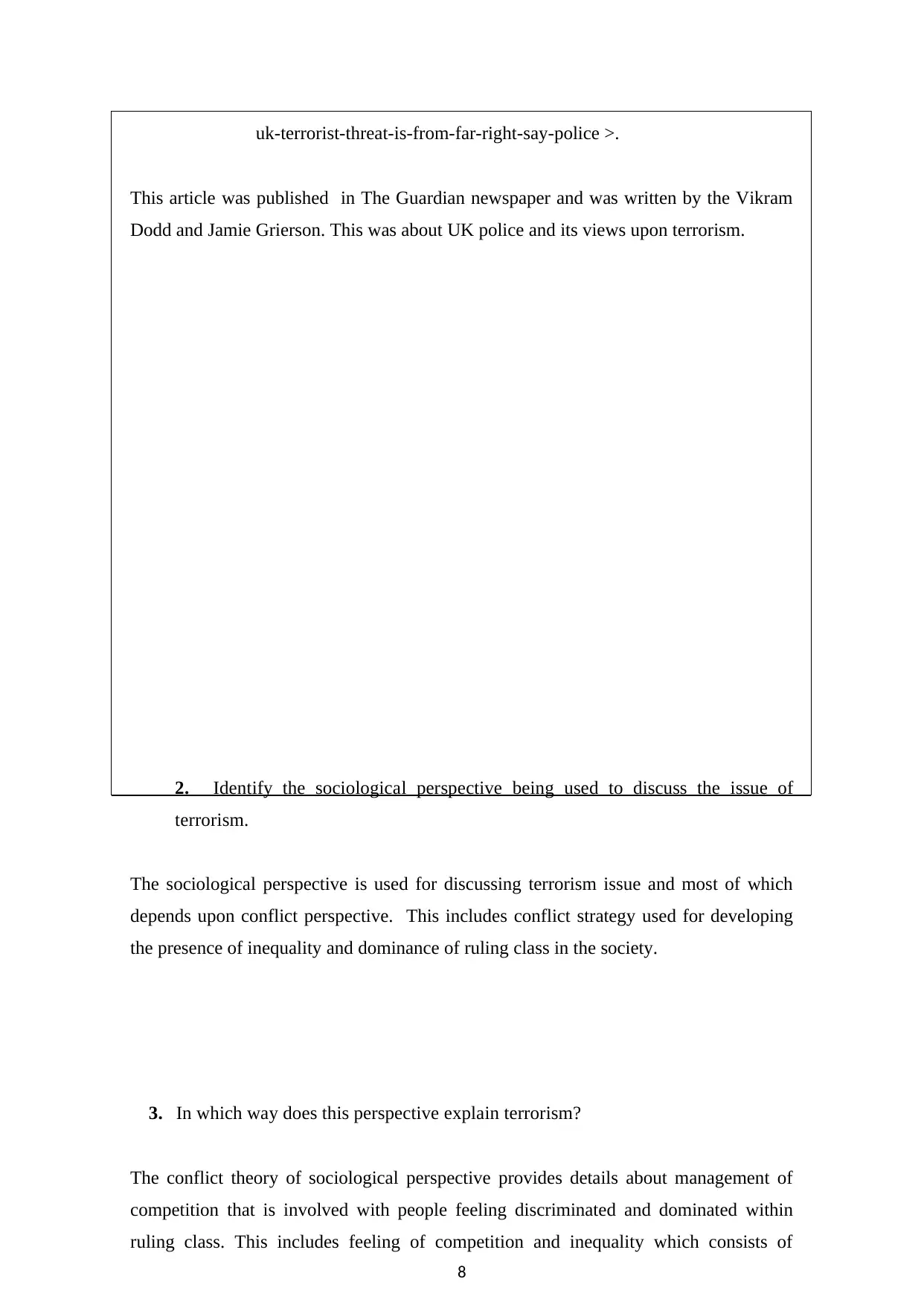
uk-terrorist-threat-is-from-far-right-say-police >.
This article was published in The Guardian newspaper and was written by the Vikram
Dodd and Jamie Grierson. This was about UK police and its views upon terrorism.
2. Identify the sociological perspective being used to discuss the issue of
terrorism.
The sociological perspective is used for discussing terrorism issue and most of which
depends upon conflict perspective. This includes conflict strategy used for developing
the presence of inequality and dominance of ruling class in the society.
3. In which way does this perspective explain terrorism?
The conflict theory of sociological perspective provides details about management of
competition that is involved with people feeling discriminated and dominated within
ruling class. This includes feeling of competition and inequality which consists of
8
This article was published in The Guardian newspaper and was written by the Vikram
Dodd and Jamie Grierson. This was about UK police and its views upon terrorism.
2. Identify the sociological perspective being used to discuss the issue of
terrorism.
The sociological perspective is used for discussing terrorism issue and most of which
depends upon conflict perspective. This includes conflict strategy used for developing
the presence of inequality and dominance of ruling class in the society.
3. In which way does this perspective explain terrorism?
The conflict theory of sociological perspective provides details about management of
competition that is involved with people feeling discriminated and dominated within
ruling class. This includes feeling of competition and inequality which consists of
8
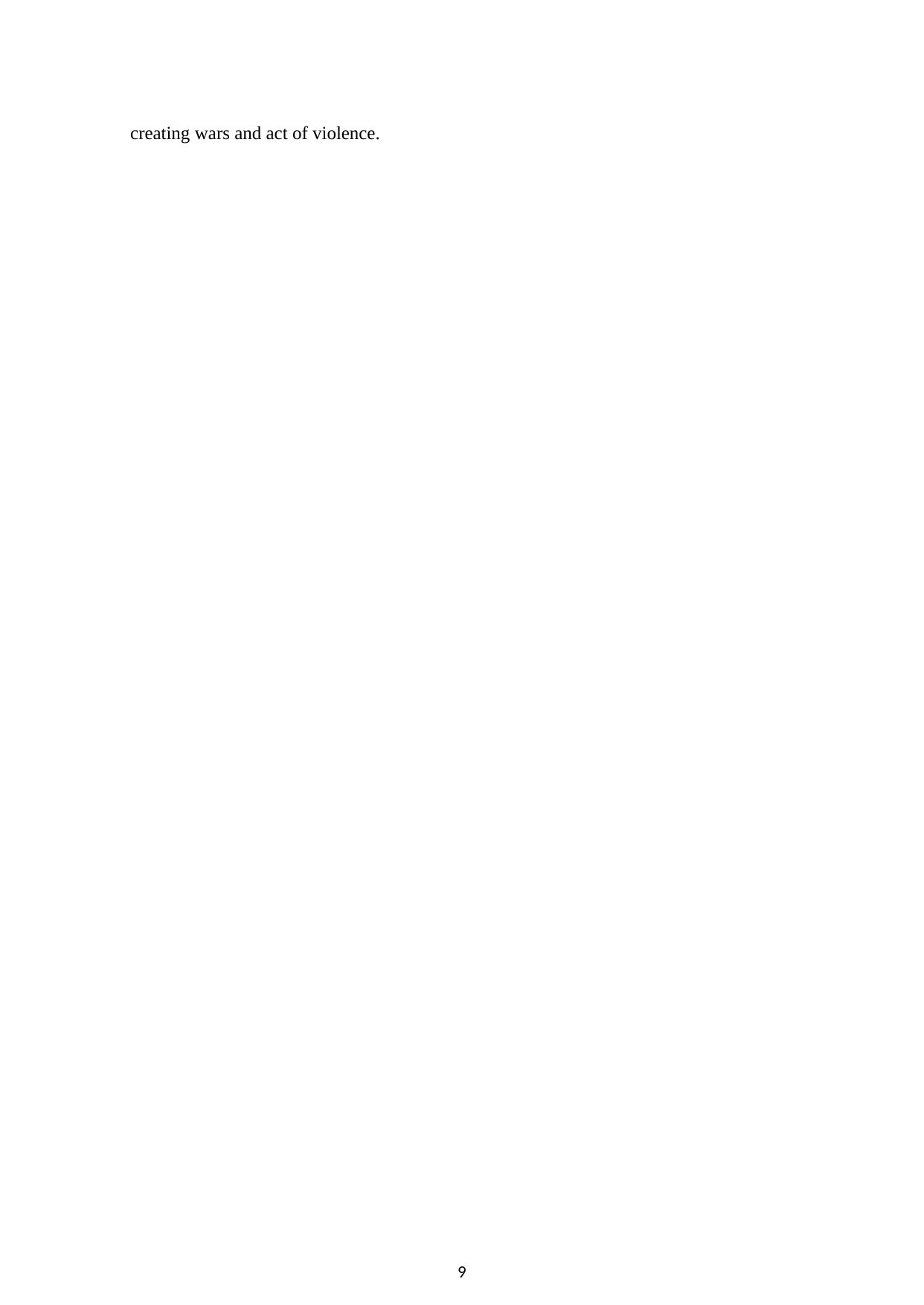
creating wars and act of violence.
9
9
⊘ This is a preview!⊘
Do you want full access?
Subscribe today to unlock all pages.

Trusted by 1+ million students worldwide
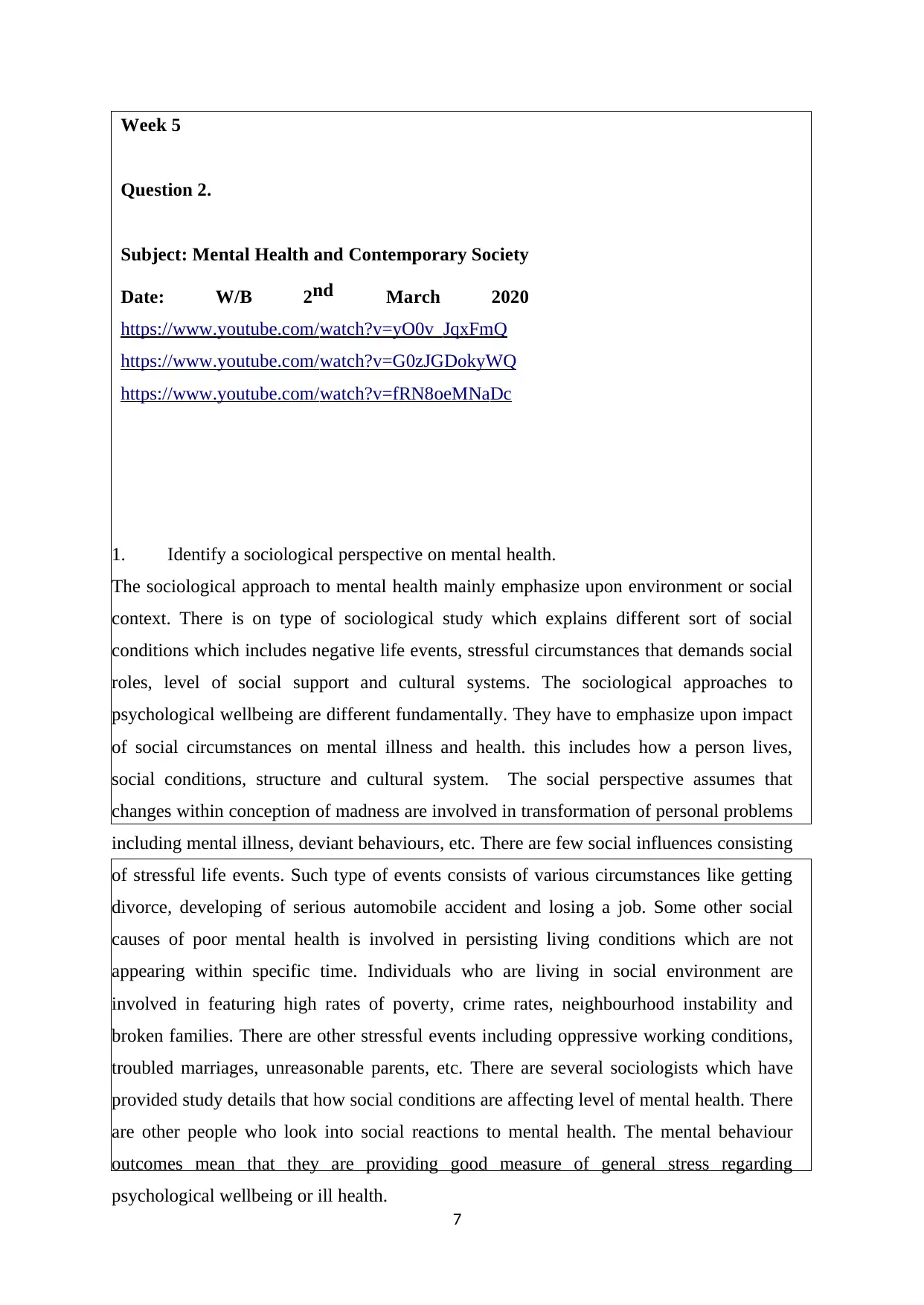
7
Week 5
Question 2.
Subject: Mental Health and Contemporary Society
Date: W/B 2nd March 2020
https://www.youtube.com/watch?v=yO0v_JqxFmQ
https://www.youtube.com/watch?v=G0zJGDokyWQ
https://www.youtube.com/watch?v=fRN8oeMNaDc
1. Identify a sociological perspective on mental health.
The sociological approach to mental health mainly emphasize upon environment or social
context. There is on type of sociological study which explains different sort of social
conditions which includes negative life events, stressful circumstances that demands social
roles, level of social support and cultural systems. The sociological approaches to
psychological wellbeing are different fundamentally. They have to emphasize upon impact
of social circumstances on mental illness and health. this includes how a person lives,
social conditions, structure and cultural system. The social perspective assumes that
changes within conception of madness are involved in transformation of personal problems
including mental illness, deviant behaviours, etc. There are few social influences consisting
of stressful life events. Such type of events consists of various circumstances like getting
divorce, developing of serious automobile accident and losing a job. Some other social
causes of poor mental health is involved in persisting living conditions which are not
appearing within specific time. Individuals who are living in social environment are
involved in featuring high rates of poverty, crime rates, neighbourhood instability and
broken families. There are other stressful events including oppressive working conditions,
troubled marriages, unreasonable parents, etc. There are several sociologists which have
provided study details that how social conditions are affecting level of mental health. There
are other people who look into social reactions to mental health. The mental behaviour
outcomes mean that they are providing good measure of general stress regarding
psychological wellbeing or ill health.
Week 5
Question 2.
Subject: Mental Health and Contemporary Society
Date: W/B 2nd March 2020
https://www.youtube.com/watch?v=yO0v_JqxFmQ
https://www.youtube.com/watch?v=G0zJGDokyWQ
https://www.youtube.com/watch?v=fRN8oeMNaDc
1. Identify a sociological perspective on mental health.
The sociological approach to mental health mainly emphasize upon environment or social
context. There is on type of sociological study which explains different sort of social
conditions which includes negative life events, stressful circumstances that demands social
roles, level of social support and cultural systems. The sociological approaches to
psychological wellbeing are different fundamentally. They have to emphasize upon impact
of social circumstances on mental illness and health. this includes how a person lives,
social conditions, structure and cultural system. The social perspective assumes that
changes within conception of madness are involved in transformation of personal problems
including mental illness, deviant behaviours, etc. There are few social influences consisting
of stressful life events. Such type of events consists of various circumstances like getting
divorce, developing of serious automobile accident and losing a job. Some other social
causes of poor mental health is involved in persisting living conditions which are not
appearing within specific time. Individuals who are living in social environment are
involved in featuring high rates of poverty, crime rates, neighbourhood instability and
broken families. There are other stressful events including oppressive working conditions,
troubled marriages, unreasonable parents, etc. There are several sociologists which have
provided study details that how social conditions are affecting level of mental health. There
are other people who look into social reactions to mental health. The mental behaviour
outcomes mean that they are providing good measure of general stress regarding
psychological wellbeing or ill health.
Paraphrase This Document
Need a fresh take? Get an instant paraphrase of this document with our AI Paraphraser
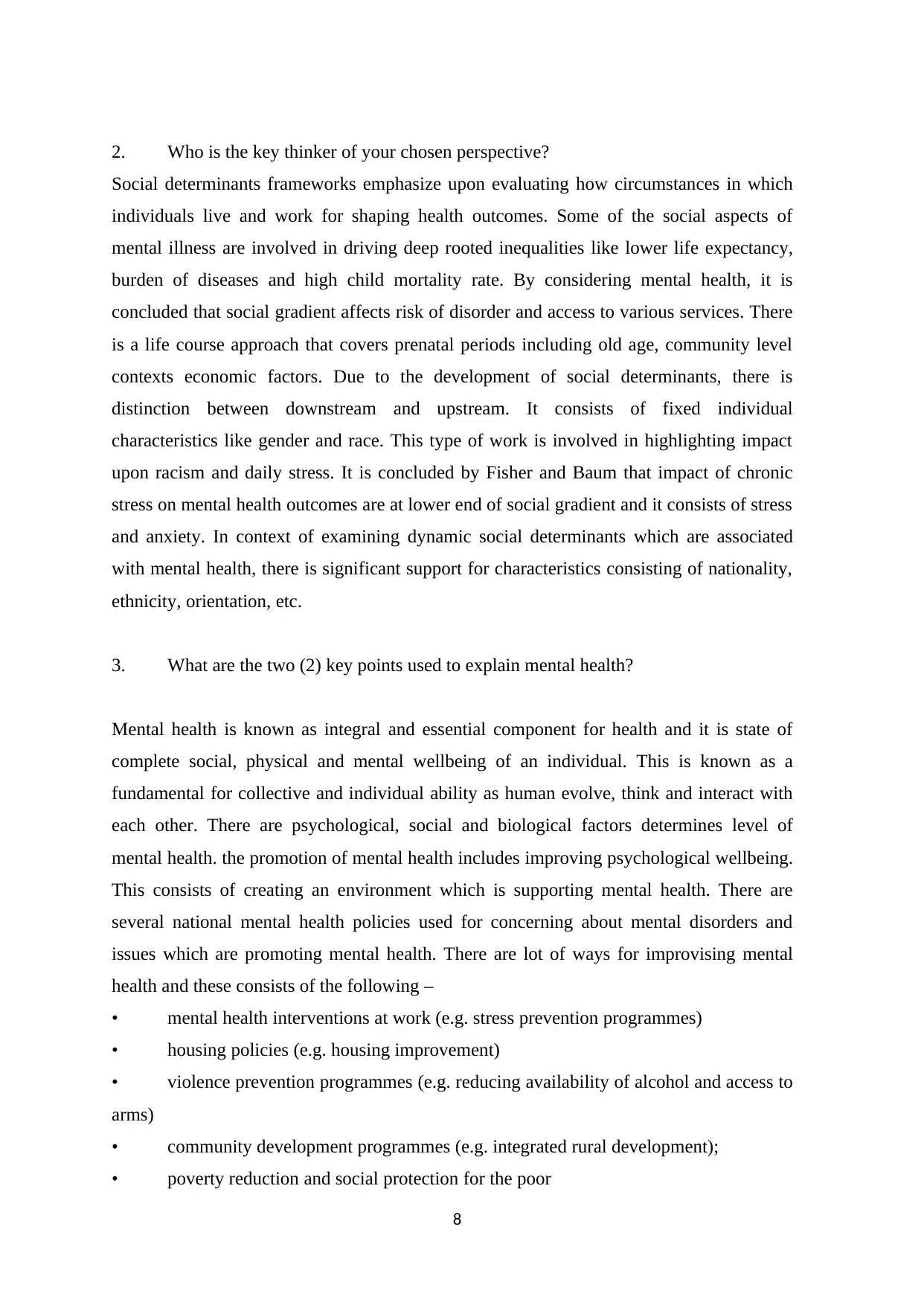
8
2. Who is the key thinker of your chosen perspective?
Social determinants frameworks emphasize upon evaluating how circumstances in which
individuals live and work for shaping health outcomes. Some of the social aspects of
mental illness are involved in driving deep rooted inequalities like lower life expectancy,
burden of diseases and high child mortality rate. By considering mental health, it is
concluded that social gradient affects risk of disorder and access to various services. There
is a life course approach that covers prenatal periods including old age, community level
contexts economic factors. Due to the development of social determinants, there is
distinction between downstream and upstream. It consists of fixed individual
characteristics like gender and race. This type of work is involved in highlighting impact
upon racism and daily stress. It is concluded by Fisher and Baum that impact of chronic
stress on mental health outcomes are at lower end of social gradient and it consists of stress
and anxiety. In context of examining dynamic social determinants which are associated
with mental health, there is significant support for characteristics consisting of nationality,
ethnicity, orientation, etc.
3. What are the two (2) key points used to explain mental health?
Mental health is known as integral and essential component for health and it is state of
complete social, physical and mental wellbeing of an individual. This is known as a
fundamental for collective and individual ability as human evolve, think and interact with
each other. There are psychological, social and biological factors determines level of
mental health. the promotion of mental health includes improving psychological wellbeing.
This consists of creating an environment which is supporting mental health. There are
several national mental health policies used for concerning about mental disorders and
issues which are promoting mental health. There are lot of ways for improvising mental
health and these consists of the following –
• mental health interventions at work (e.g. stress prevention programmes)
• housing policies (e.g. housing improvement)
• violence prevention programmes (e.g. reducing availability of alcohol and access to
arms)
• community development programmes (e.g. integrated rural development);
• poverty reduction and social protection for the poor
2. Who is the key thinker of your chosen perspective?
Social determinants frameworks emphasize upon evaluating how circumstances in which
individuals live and work for shaping health outcomes. Some of the social aspects of
mental illness are involved in driving deep rooted inequalities like lower life expectancy,
burden of diseases and high child mortality rate. By considering mental health, it is
concluded that social gradient affects risk of disorder and access to various services. There
is a life course approach that covers prenatal periods including old age, community level
contexts economic factors. Due to the development of social determinants, there is
distinction between downstream and upstream. It consists of fixed individual
characteristics like gender and race. This type of work is involved in highlighting impact
upon racism and daily stress. It is concluded by Fisher and Baum that impact of chronic
stress on mental health outcomes are at lower end of social gradient and it consists of stress
and anxiety. In context of examining dynamic social determinants which are associated
with mental health, there is significant support for characteristics consisting of nationality,
ethnicity, orientation, etc.
3. What are the two (2) key points used to explain mental health?
Mental health is known as integral and essential component for health and it is state of
complete social, physical and mental wellbeing of an individual. This is known as a
fundamental for collective and individual ability as human evolve, think and interact with
each other. There are psychological, social and biological factors determines level of
mental health. the promotion of mental health includes improving psychological wellbeing.
This consists of creating an environment which is supporting mental health. There are
several national mental health policies used for concerning about mental disorders and
issues which are promoting mental health. There are lot of ways for improvising mental
health and these consists of the following –
• mental health interventions at work (e.g. stress prevention programmes)
• housing policies (e.g. housing improvement)
• violence prevention programmes (e.g. reducing availability of alcohol and access to
arms)
• community development programmes (e.g. integrated rural development);
• poverty reduction and social protection for the poor
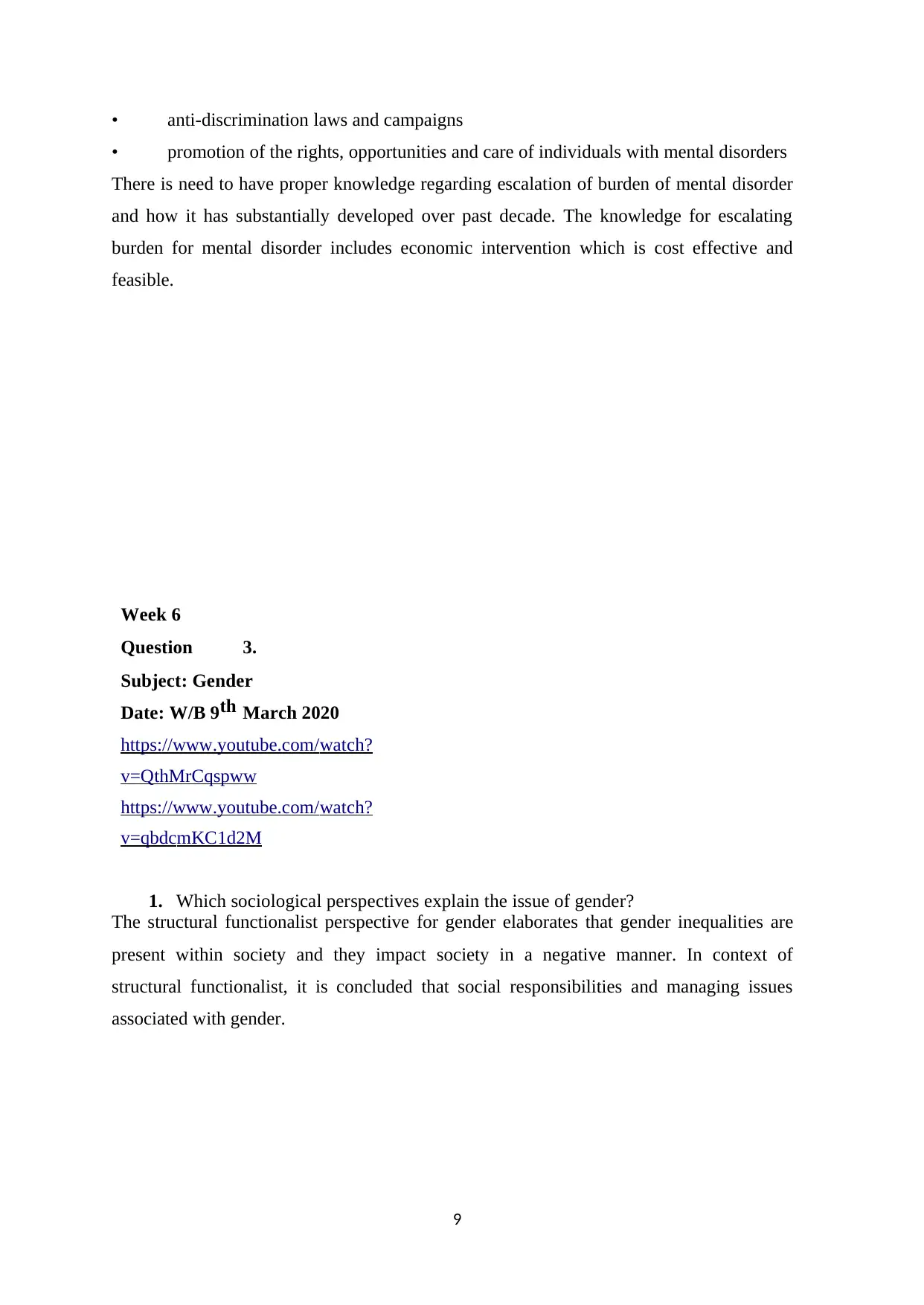
9
• anti-discrimination laws and campaigns
• promotion of the rights, opportunities and care of individuals with mental disorders
There is need to have proper knowledge regarding escalation of burden of mental disorder
and how it has substantially developed over past decade. The knowledge for escalating
burden for mental disorder includes economic intervention which is cost effective and
feasible.
Week 6
Question 3.
Subject: Gender
Date: W/B 9th March 2020
https://www.youtube.com/watch?
v=QthMrCqspww
https://www.youtube.com/watch?
v=qbdcmKC1d2M
1. Which sociological perspectives explain the issue of gender?
The structural functionalist perspective for gender elaborates that gender inequalities are
present within society and they impact society in a negative manner. In context of
structural functionalist, it is concluded that social responsibilities and managing issues
associated with gender.
• anti-discrimination laws and campaigns
• promotion of the rights, opportunities and care of individuals with mental disorders
There is need to have proper knowledge regarding escalation of burden of mental disorder
and how it has substantially developed over past decade. The knowledge for escalating
burden for mental disorder includes economic intervention which is cost effective and
feasible.
Week 6
Question 3.
Subject: Gender
Date: W/B 9th March 2020
https://www.youtube.com/watch?
v=QthMrCqspww
https://www.youtube.com/watch?
v=qbdcmKC1d2M
1. Which sociological perspectives explain the issue of gender?
The structural functionalist perspective for gender elaborates that gender inequalities are
present within society and they impact society in a negative manner. In context of
structural functionalist, it is concluded that social responsibilities and managing issues
associated with gender.
⊘ This is a preview!⊘
Do you want full access?
Subscribe today to unlock all pages.

Trusted by 1+ million students worldwide
1 out of 26
Related Documents
Your All-in-One AI-Powered Toolkit for Academic Success.
+13062052269
info@desklib.com
Available 24*7 on WhatsApp / Email
![[object Object]](/_next/static/media/star-bottom.7253800d.svg)
Unlock your academic potential
Copyright © 2020–2025 A2Z Services. All Rights Reserved. Developed and managed by ZUCOL.





